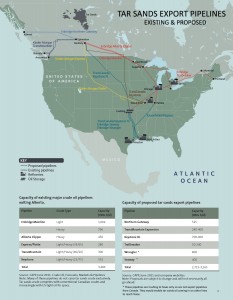 Report Published December 2011
Report Published December 2011
Download the full report
Tar sands extraction projects are moving forward with increasing pace. The industry ambition is to grow production from today’s level an extraordinary 140 percent by 2025.
Environmental impacts are a concern, particularly greenhouse gas emissions and water. Spills from existing pipelines have put pipeline route communities on high alert. The over 1 million gallons spilled into the Kalamazoo River in Michigan in July 2010 is still proving impossible to clean up.
Public dissent over these impacts is starting to make itself felt in the tar sands belt through increasingly vehement opposition to the pipeline projects that the landlocked industry relies upon for its future growth.
Keystone XL was already two years behind schedule when the State Department announced a further 12-18 month delay in early November 2011. Enbridge’s Northern Gateway faces unprecedented opposition from British Columbia First Nation communities along its route and among the coastal communities that would be threatened by the resulting oil tanker traffic. It has been delayed at least one year.
Significant opposition also exists against less discussed projects such as Kinder Morgan’s TransMountain pipeline expansion and Enbridge’s Trailbreaker project. see map
While it seems unlikely that all of these options will fail, the challenges they face may delay and disrupt the tar sands industry’s ambitious schedule for growth.
Many international oil companies have become hugely dependent on Canadian tar sands for their future growth. The resource constitutes the biggest single liquids component in the long term reserves for some of them. To achieve the production growth that would monetize these reserves will require all the currently proposed pipelines and more.
Such is the size of the resource and the limitations of the regional market, tar sands must access the open ocean to grow. Building enough pipeline capacity to deep water ports may turn out to be the greatest challenge facing tar sands production growth.
The report shows that:
- Tar sands oil is among the biggest component of many major oil company reserves;
- Four major tar sands pipeline proposals face significant public opposition in the United States and Canada;
- Without these pipelines, the industry’s ambitious growth plans cannot be realized.
- The incentive for Gulf Coast refiners to make long term commitments to deliveries from tar sands pipelines is diminishing due to uncertainty over permitting and growing supplies from elsewhere.
This report is part of an ongoing dialogue with the investment community that examines a wide range of investment risk issues surrounding tar sands production.
As some of the world’s most expensive to produce oil, the tar sands is not the great boon that the industry would have investors believe. The kind of exponential growth the industry would like to achieve depends on benign circumstances on a number of levels. These include minimal regulation, cheap natural gas and a continued social license to operate, not only within Alberta, but among the communities through which pipelines will pass as well as among those in which refineries will process this heavy sour oil.
We are seeing that this social license is increasingly being challenged.
Download the full report

